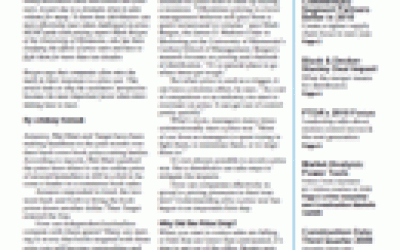
Bureau of Labor Statistics employment projections provide a guide on potential growth markets for distributors.

Bureau of Labor Statistics employment projections provide a guide on potential growth markets for distributors.

It's been a tough year all around, but it's been a bit easier for a group of East Coast distributors who meet four times a year to advise and help one another. We call ourselves the "1% Club" because if we don't do nearly everything right, that's all we have to celebrate at the end of the year!
We sell shampoo, pie filling, dental floss, …

MDM Webcast tackles the question: Which path will lead you to profitability in 2010?
Facilities maintenance distributor W.W. Grainger, with more than $6.5 billion in annual sales. recently held its annual analyst meeting. This article provides an overview of its key talking points in the meeting, including Grainger’s market forecasts, acquisition plans, MRO customer mindset and global plans.
Details in this article were taken from Grainger’s annual analyst meeting Webcast at grainger.com.
Grainger CEO Jim Ryan said it right this month at the distributor’s annual analyst meeting: “I’m getting tired of looking at negative numbers, and I know you are, too.” The company presented some much more optimistic numbers for 2010, and said its approach to the past year of down has helped prop it up for good growth going forward.
Ryan said the downturn “has had a profound impact on not only our business but on our industry.”
Grainger has outperformed the industry as …

In recent presentations, Interline outlined growth initiatives.

Many distributors have been drawn into price wars, in part due to a dramatic drop in sales volume for many. To learn how distributors can more effectively react when challenged on price, MDM spoke with pricing expert Mark Bergen of the University of Minnesota, who has been studying the effects of price wars and how to fight them for more than two decades.
Bergen says that companies often miss the mark in their responses to a price war. This article looks at why the customers’ perspective becomes the most important factor when determining how to react.
Amazon, Wal-Mart and Target have been making headlines in the past month over their hard-cover book price-cutting battles. According to reports, Wal-Mart sparked
A distributor must decide whether the latest ideas fit their business.
WESCO’s sales to the government grew 15% in the third quarter.

At North American Building Material Distribution Association meeting, companies show resilience and creativity in current conditions.


Bill McCleave: Dig deep to assess new and existing markets.

Mike Marks at PTDA/FPDA: Now is the time to take control of company’s direction.


Some online resources to help distributors and manufacturers keep on top of new green spending incentives in their states.

This article looks at the roles of each part of the organization in strategic pricing. Using a sports analogy, the author refers to the Sales Function as the offense, the Operations Function as the defense, and the Purchasing Function as special teams. IT, Finance, Credit and HR play support roles, enabling the team to be in a position to win. And management is the coaching staff. Running a complex “play” like strategic pricing requires all functions to work in concert.
Much has already been written about the “science” of strategic pricing. I have written some of it, including Strategic Pricing for Distributors, published by the NAW Institute earlier this year. I intended the book as a do-it-yourself explanation of strategic pricing.
The magicians Penn & Teller famously perform a magic act that reveals the secrets of magic tricks. But even if you know the secrets, learning how to execute those illusions requires skill and experience. And even if you understand the relatively simple concepts behind strategic pricing, successful implementation is challenging work.

Moving an industry toward such a big change will be a challenge for company leaders: Here are some tips learned at the IDEA e-Biz Forum this week.

Short-term thinking is out; the big picture is in.

Grainger is setting the example for distributors looking to shake off defensive mode.
The outflow of manufacturing to “low-cost” countries keeps resonating lately as I envision how this next growth cycle takes shape. Before the heady days of the dot-com era distracted many businesses from their core focus and presented others with opportunity, industry change centered on the dramatic shift many North American manufacturers were making to offshore production.
Today there are a number of indicators that manufacturing might migrate back to a regional or at least continental scale.

By providing your email, you agree to receive announcements from us and our partners for our newsletter, events, surveys, and partner resources per MDM Terms & Conditions. You can withdraw consent at any time.
Wholesale distribution news and trends delivered right to your inbox.
Sign-up for our free newsletter and get:
